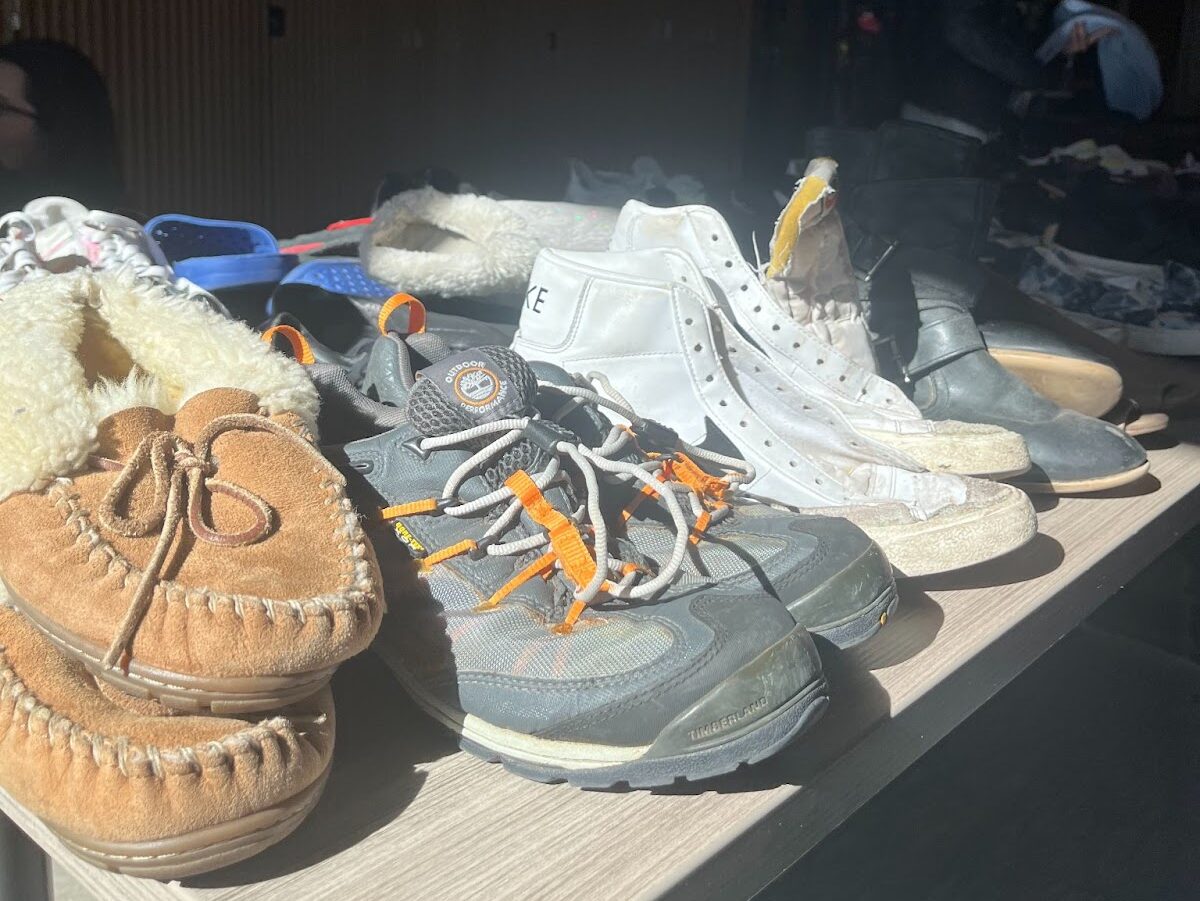Shoes for $ 1 a pair are laid out on the thrift tables [Photo by Eden Bollschweiler]
By Eden Bollschweiler
The University of Denver Community Commons was abuzz with students last Monday, as they milled around dozens of tables with piles and piles of clothes. At the Winter $1 Sale, University of Denver (DU) students sorted through swathes of secondhand clothing and rummaged through piles of eclectic accessories in hopes of the “perfect find.”
For students, it’s a clear win: cheap clothes for sale smack dab in the middle of campus. But the DU thrift store, branching from the Center for Sustainability gets more than just money from the annual sale.
“The winter $1 sale specifically was to – in a last kind of attempt – just sell clothes to anyone at DU before we donated it to other organizations,”

Jacob Tonozzi works the cash register | Photo by Eden Bollschweiler
says Jacob Tonozzi, an intern at the Center for Sustainability and manager at the DU Thrift store. “Now it’s just kind of like a tradition … a really great way to spread the word about the thrift store.”
All of the clothes from the sale come from the school’s thrift store, which is fueled by student donations and student spending. But Tonozzi says the center’s mission to have affordable and accessible clothing was hampered when they realized they were running out of space.
Thus, the first Winter 1$ Sale was born in 2021, as the Center for Sustainability searched for new ways to clear excessive student donations that were sitting untouched. Although the thrift store could just donate the clothing to external organizations, they wanted to keep clothes on campus as much as possible and nurture a circular economy at DU.
A circular economy is an economic model where products are intended to be part of a larger cycle of consumption, rather than a linear model where clothes inevitably end at the dump. This model is a part of the thrift store’s solution for reducing clothing waste that burdens landfills, with average US textile waste exceeding 11 million tons each year.
At this year’s Winter $1 Sale, the circular economy model wasn’t limited to clothing. Local artists and jewelry makers set up shop around the room, displaying their handmade goods for sale.
Student artist Jazzy Perez says events like these help them connect to new customers and promote their small businesses.

Jazzy Perez shows off their art at their booth | Photo by Eden Bollschweiler
“All these people, even today are like ‘Oh, I have this necklace that I bought from you,’” said Perez. “And I don’t know who they are,” they said with a chuckle. “But it’s nice to know that people spread it [my art] around.”
The event also featured a favorite artist competition where Ainhoa Calderon won first place and Perez won second. Both student artists received gift cards to the local secondhand craft store, Recreative, so they could continue their art and find sustainable funding.
For stakeholders at the sale like Tonozzi and Perez, the event is a vehicle for exposure, spending and networking that doesn’t have to compromise on principles of sustainability. Still, this once-a-year sale, says Tonozzi, doesn’t alleviate all pressure on consumers to be more sustainable. Rapidly shrinking trend cycles, mass consumerism and social media glamorization of clothing hauls still outpace sustainability efforts, effectively suffocating landfills in mounds of cheap cotton and polyesters.

“Thrifting is not the panacea to this overarching consumerist problem,” said Tonozzi. “But it’s still something that’s a more sustainable option if you want or need to purchase more clothes.”
Students look through piles of donated clothing | Photo by Eden Bollschweiler
As students shuffle through last year’s closet purge, they may not realize that the couple of dollars they spend are worth more than face value. It means supporting local artists, funding their campus thrift store and promoting a viable economic model of consumption, one where imagination and innovation are more important than made-for-landfill purchases.










